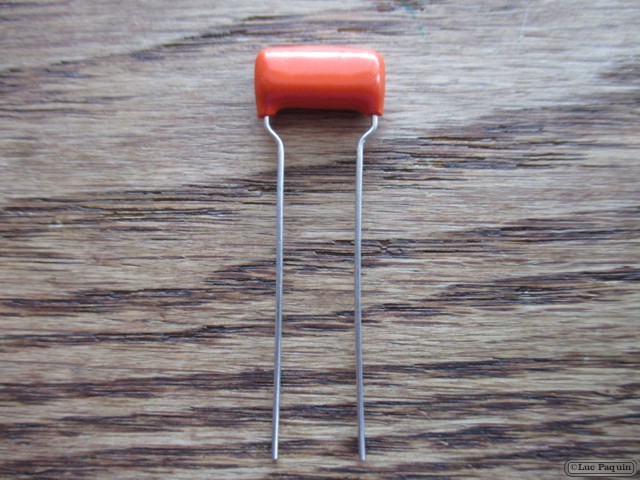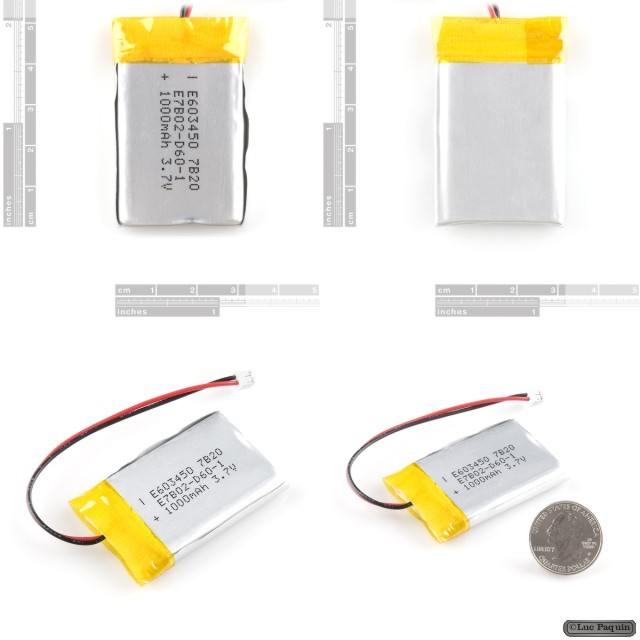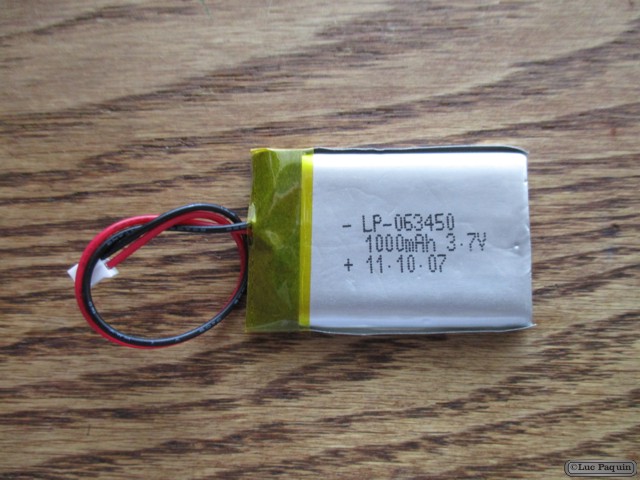Microcontrollers
Microcontrollers
SparkFun – Nut – Nylon Locknut (4-40)
Steward-MacDonald – Orange Drop Caps
Steward-MacDonald: 1281
Upgrade to the quality caps used in Fender and Gibson guitars.
Made of durable high grade polyester, and favorites for vintage restorations or new builds.
Capacitors are energy-storage devices that filter the high frequencies. A cap lets the tone control roll off the treble response, progressively warming the tone. The higher the value, the more bass output from the tone control at its “zero” setting.
A cap wired to a potentiometer creates a standard tone control, as explained in this Article: How a tone control works.
100V. Sold individually.
- .022uF 223K Humbucker Tone
Don Luc
SparkFun – Screw – Phillips Head (1/4″, 4-40)
Adafruit – Lithium Ion Battery – 3.7v 2000mAh
Adafruit: 2011
Description
Lithium ion polymer (also known as ‘lipo’ or ‘lipoly’) batteries are thin, light and powerful. The output ranges from 4.2V when completely charged to 3.7V. This battery has a capacity of 2000mAh. If you need a larger (or smaller!) battery, we have a full range of LiPoly batteries
The batteries come pre-attached with a genuine 2-pin JST-PH connector as shown and include the necessary protection circuitry. Because they have a genuine JST connector, not a knock-off, the cable wont snag or get stuck in a matching JST jack, they click in and out smoothly.
The included protection circuitry keeps the battery voltage from going too high (over-charging) or low (over-use) which means that the battery will cut-out when completely dead at 3.0V. It will also protect against output shorts. However, even with this protection it is very important that you only use a LiIon/LiPoly constant-voltage/constant-current charger to recharge them and at a rate of 2A or less (500mA is best). We suggest our Micro Lipo charger, which has a 100mA default rate. You can also set the Micro Lipo to 500mA rate for a faster charge.
Like most lipos, the batteries we sell do not have thermistors built in. This is why we suggest charging at 1 C or even less – 100 to 500mA is a good rate, and available from any USB port if using a USB-powered charger.
Additional safety notes: Do not use a NiMH/NiCad/lead-acid charger! Also, do not abuse these batteries, do not short, bend, crush or puncture. As with all Lithium ion polymer batteries and with any power source – they should be used by experts who are comfortable working with power supplies.
Technical Details
- Dimensions: 60mm x 36mm x 7mm / 2.4″ x 1.4″ x 0.3″
- Weight: 34g
- Nominal Capacity: 2000mAh ±2%
- Nominal Voltage: 3.7V
- Standard Charge Current: ~0.2C / 0.5A
- Charge Cut-Off Voltage: 4.2V
- Standard Discharge Current: ~0.2C / 0.5A
Don Luc
SparkFun – Polymer Lithium Ion Battery – 1000mAh
SparkFun: PRT-00339
Description: These are very slim, extremely light weight batteries based on the new Polymer Lithium Ion chemistry. This is the highest energy density currently in production. Each cell outputs a nominal 3.7V at 1000mAh! Comes terminated with a standard 2-pin JST-PH connector – 2mm spacing between pins. These batteries require special charging. Do not attempt to charge these with anything but a specialized Lithium Polymer charger.
Battery includes built-in protection against over voltage, over current, and minimum voltage. Please use caution when using this battery in wearable projects. When using conductive thread, a short in the thread can create sparks and heat. We recommend using coin cell batteries for beginners.
Note: Although these cells are rated for 2C continuous discharge, the wiring and connectors are only rated up to 1A, so be sure to take that into account when determining your power requirements.
Note: Be careful with the JST connectors. They can stick in pretty good and tugging on them can damage the connector.
Dimensions: 50.8 x 33.5 x 5.9 mm
Weight: 22g
Features:
- Excellent long-term self-discharge rates (<8% per month)
- Robust power source under extreme conditions (-25 to 60C)
Don Luc
SparkFun – Polymer Lithium Ion Battery – 850mAh
SparkFun: PRT-00341
Description: These are very slim, extremely light weight batteries based on the new Polymer Lithium Ion chemistry. This is the highest energy density currently in production. Each cells outputs a nominal 3.7V at 850mAh! Comes terminated with a standard 2-pin JST-PH connector – 2mm spacing between pins. These batteries require special charging. Do not attempt to charge these with anything but a specialized LiPo charger.
Battery includes built-in protection against over voltage, over current, and minimum voltage. Please use caution when using this battery in wearable projects. When using conductive thread, a short in the thread can create sparks and heat. We recommend using coin cell batteries for beginners.
Note: Although these cells are rated for 2C continuous discharge, the wiring and connectors are only rated up to 1A, so be sure to take that into account when determining your power requirements.
Note: Be careful with the JST connectors. They can stick in pretty good and tugging on them can damage the connector.
Dimensions: 5.7×29.5×48.27mm
Weight: 18.5g
Features:
- 2C continuous discharge
- Excellent long-term self-discharge rates (<8% per month)
- Robust power source under extreme conditions (-25 to 60C)
Don Luc
SparkFun – Polymer Lithium Ion Battery – 400mAh
SparkFun: PRT-10718
Description: This is a very small, extremely light weight battery based on the new Polymer Lithium Ion chemistry. This is the highest energy density currently in production. Each cells outputs a nominal 3.7V at 400mAh! Comes terminated with a standard 2-pin JST-PH connector – 2mm spacing between pins. These batteries require special charging. Do not attempt to charge these with anything but a specialized Lithium Polymer charger.
Battery includes built-in protection against over voltage, over current, and minimum voltage. Please use caution when using this battery in wearable projects. When using conductive thread, a short in the thread can create sparks and heat. We recommend using coin cell batteries for beginners.
Note: Be careful with the JST connectors. They can stick in pretty good and tugging on them can damage the connector.
Dimensions: 5x25x35mm
Weight: 9g
Features:
- 2C continuous discharge – very high for low price
- Excellent long-term self-discharge rates (<8% per month)
- Robust power source under extreme conditions (-25 to 60C)
Don Luc
SparkFun – Polymer Lithium Ion Battery – 110mAh
SparkFun: PRT-00731
Description: This is a very small, extremely light weight battery based on the new Polymer Lithium Ion chemistry. This is the highest energy density currently in production. Each cells outputs a nominal 3.7V at 110mAh! Comes terminated with a standard 2-pin JST-PH connector – 2mm spacing between pins. These batteries require special charging. Do not attempt to charge these with anything but a specialized Lithium Polymer charger.
Battery includes built-in protection against over voltage, over current, and minimum voltage. Please use caution when using this battery in wearable projects. When using conductive thread, a short in the thread can create sparks and heat. We recommend using coin cell batteries for beginners.
Note: Be careful with the JST connectors. They can stick in pretty good and tugging on them can damage the connector.
Dimensions: 5.7x12x28mm
Weight: 2.65g
Features:
- Excellent long-term self-discharge rates (<8% per month)
- Robust power source under extreme conditions (-25 to 60C)
Don Luc
SparkFun – Standoffs Plastic – (4-40; 3/4″)
Adafruit – Potentiometer Knob – Soft Touch T18 – Blue
Adafruit: 2048
Description
Oh say can you see
By the knob’s early light…
Sorry – we thought that was clever. And while it wasn’t really, this potentiometer knob definitely is. It’s a ‘soft touch’ T18 knob that works great with our Panel Mount 10K, Panel Mount 1K, and Panel Mount 100K potentiometers. The knob is designed to set directly on the potentiometer’s ridges so it’s an easy & secure fit. It has a nice feel, with a rubbery grip, tweaking it is quite fulfilling.
This is the blue version and it has a nice deep color on the inside with a striking blue line on the outside for great visibility with whatever you’re making. We also carry it in white and red if you’re looking for a variety of colors.
Technical Details
- Diameter of the top: 11mm / 0.4″
- Diameter of the base: 15mm / 0.6″
- Weight: 1g
- Colour: Blue
Don Luc




































